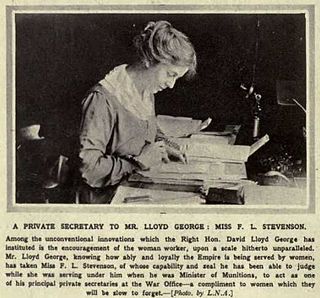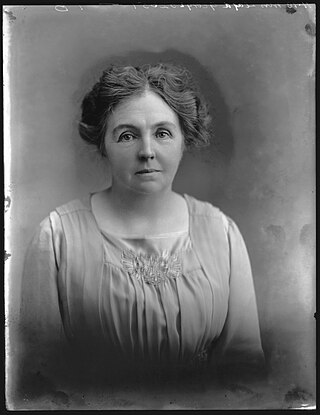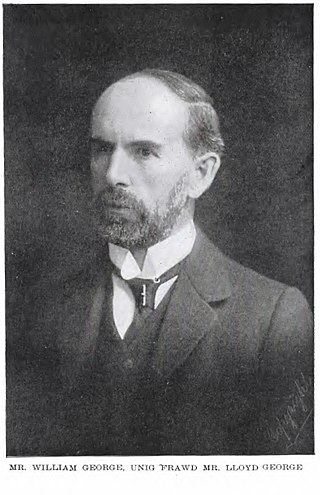
Mary Anning was an English fossil collector, dealer, and palaeontologist who became known around the world for the discoveries she made in Jurassic marine fossil beds in the cliffs along the English Channel at Lyme Regis in the county of Dorset in Southwest England. Anning's findings contributed to changes in scientific thinking about prehistoric life and the history of the Earth.

David Lloyd George, 1st Earl Lloyd-George of Dwyfor, was Prime Minister of the United Kingdom from 1916 to 1922. A Liberal Party politician from Wales, he was known for leading the United Kingdom during the First World War, for social-reform policies, for his role in the Paris Peace Conference, and for negotiating the establishment of the Irish Free State. He was the last Liberal Party prime minister; the party fell into third-party status shortly after the end of his premiership.

Llanystumdwy is a predominantly Welsh-speaking village, community and electoral ward on the Llŷn Peninsula in Wales. It lies in the traditional county of Caernarfonshire but is currently administered as part of the unitary authority of Gwynedd. It is not regarded as being part of Llŷn, but as belonging instead to the ancient commote of Eifionydd on the Cardigan Bay coast, where it has its own beach. The community includes the villages of Chwilog, Afon Wen, Llanarmon, and Llangybi, plus the hamlets of Rhoslan and Pencaenewydd.

The Life and Times of David Lloyd George is a BBC Wales drama serial first broadcast in 1981 on BBC Two. It stars Philip Madoc as David Lloyd George, the final Liberal prime minister of the UK. The cast also includes Lisabeth Miles, Kika Markham and David Markham. It was written by Elaine Morgan and produced and directed by John Hefin.

Frances Lloyd George, Countess Lloyd-George of Dwyfor, was the mistress, personal secretary, confidante and second wife of British Prime Minister David Lloyd George.
This article is about the particular significance of the year 1949 to Wales and its people.

Tŷ Newydd is a historic house in Llanystumdwy, near Criccieth, in Gwynedd, north-west Wales. Since 1990 it has housed the National Writing Centre of Wales. The centre specialises in residential creative writing and retreats. The courses are in both the English and Welsh languages, and cover many genres, forms and styles. The centre also holds regular seminars and forums.

Chwilog is a village in Gwynedd, north Wales, and located on the Llŷn Peninsula. It is in the community of Llanystumdwy, near Criccieth, and in the medieval commote of Eifionydd, named after a 5th-century ruler. It is within the Dwyfor Meirionnydd constituency in the UK Parliament and in the Senedd. The name means 'abounding in beetles' and was perhaps transferred from an earlier name of the river.

Dame Margaret Lloyd George was a Welsh humanitarian and one of the first seven women magistrates appointed in Britain in 1919. She was the wife of Prime Minister David Lloyd George from 1888 until her death in 1941.
This article is about the particular significance of the year 1905 to Wales and its people.
This article is about the particular significance of the year 1894 to Wales and its people.
This article is about the particular significance of the year 1893 to Wales and its people.
This article is about the particular significance of the year 1892 to Wales and its people.
This article is about the particular significance of the year 1890 to Wales and its people.
The Lloyd George Society is an organisation connected with, but not formally affiliated to, the Liberal Democrats. It is named after David Lloyd George, the Welsh Liberal politician who was British prime minister from 1916-1922. The Society was founded in the late 1950s by Liberals in Wales when it was known as the Welsh Liberal Weekend Schools. It met, usually at a hotel in Mid Wales, once a year to discuss topical political and social questions both domestic and foreign, with invited specialist guest speakers. A favourite location has been the Abernant Lake Hotel at Llanwrtyd Wells because this was one of the Spa towns at which Lloyd George used to spend time. Its main purpose at that time was to provide Liberal parliamentary candidates with an environment in which they could learn about the issues of the day, debate them with experts and so gain in experience and self-assurance better to equip them for the pressures of fighting general elections.

The Afon Dwyfor is a river in Gwynedd, north-west Wales, in total the river is 12+1⁄2 miles (20.1 km) in length. It rises in Cwm Dwyfor at the head of Cwm Pennant, gathers to itself numerous streams which drain the surrounding mountains from Mynydd Graig Goch in the west to Moel Hebog in the east, then flows southwest towards Dolbenmaen and out of the Snowdonia National Park.
"Lloyd George Knew My Father" is a 20th-century English schoolboy folk song. The simple lyrics consist of the phrase "Lloyd George knew my father/Father knew Lloyd George" sung to the tune of "Onward, Christian Soldiers". In the song, the two lines referring to Lloyd George are repeated incessantly, until boredom sets in. There are no lyrics other than those two lines.
Sir Hugh John Ellis-Nanney, 1st Baronet, was a Welsh landowner, magistrate and political candidate.

The Grave of David Lloyd George, stands on a bank of the Afon Dwyfor in the village of Llanystumdwy, Gwynedd, Wales. It commemorates Lloyd George who grew up in the village, was Prime Minister of the United Kingdom between 1916 and 1922, and died at Llanystumdwy in 1945. The grave and its setting were designed by Clough Williams-Ellis, the architect of Portmerion and a lifelong friend of Lloyd George. The grave comprises a boulder set in an oval enclosure, the walls of which bear two slate plaques recording Lloyd George's name and the years of his birth and death. It is a Grade II* listed structure.

William George was a Welsh solicitor and public figure who served for 60 years as a member of Caernarfonshire County Council. He was the younger brother of the Liberal Prime Minister David Lloyd George.













